Visibility is for miles, the sky idiot-the blue with the woman drifting molntrasor.
Also on Stadsgårdskajen in the Photographic, it looks like Lars tunbjörk's images. There is a bus with bagageluckorna on anchor, surrounded by people with Finlandsbåten, conference delegates with rullväskor, already småberusade american and the ditto aunts and uncles. The atmosphere is spirited. The flags patters in the friskande nordvästan.
I strum a few cards with my telephone and look specifically to get with the word LARSSONBUSS in the picture, but don't get it as A still.
Lars tunbjörk's secret , or at least one of the secrets that are behind the unmistakable style of Sweden in recent times most famous photographer, dead since 2015, hiding in a small booth in a good piece on fotografiska's retrospective exhibition.
It is a handheld flash, apparently homemade, and made of a white lampkupa of the standard model. The unit does not look like much, but it is, after all, the one who has scored tunbjörk's images to shine in that distinctive way, even if they happen to happen at night or during a gråkall day of sports. The hive provides a strong but also diffuserat light that lifts ilbet or lowers all the pixels to the same betydelsenivå, and enough you can call it a kind of nivelleringseffekt. Equal for everything and everyone, to speak moderatiska.
for A typical picture (or tunbjörkare as they are usually called), out of the genombrottsboken ”the Country except themselves”, show, for example, an interior of a stockholmsk supermarket where lucia greets the visitor with a coffee tray. The girl is cute, but for the image as it seems to offset the equal if you look at her or on the envelope with the message ”CLEMENTINES 16,90/KG”. Everything seems to be for sale in the midst of it in the picture, and probably lets itself be read as a gräll, and eerie parallel to it with A sort of the painter, Peter Tillbergs dystopia ”are you profitable, little friend?” from 1972.
In the photograph is also a okristlig sharpness which the viewer is interested in, such as fruktdiskens of the brand, ”STOLE”, and for the small holders with the plastic bags. And is it not the ”MAXWELL HOUSE” on the kaffemuggarna? Bildutsnittet seems haphazard, which further contributes to the fact, to absolve itself of the idea on to accommodate an actual centre, or perhaps it is there as Henri Cartier-Bresson wanted to call for narrative focus.
Photo: Lars Tunbjörk”Ullared” from the series ”I love Borås”.”the Country except themselves” were at all something of a shock when it came out in 1993 (Journal), not least in virtue of its bjärthet. So far, virtually all Swedish serious photography (think, journal, ETC, Christer Strömholm , and so on) languished in grynigt black and white, while color was reserved for fashion and advertising. It was not less odd of Tunbjörk was with the flash, and then also with a strange thing that seemed to churn out vulgar Legofärger wherever it happened to turn around its opaque porslinsnylle.
According to Tunbjörk was the intention of the book to depict the crumbling welfare state, so that it behaved in the recession of the early 1990s, the years when the empire stood and shivered on the brink of the internet. And probably seen it crumble, always. It simply looks too damn ugly in the midst of it in the pictures: half-naked, vacationing bodies (the flash!) ägnande to the average extrapriskonsumism or (flash!) gluffande in itself, ice cream and other snabbföda. Everywhere ongoing degradation processes, sprickande concrete, bulging facades and the leaning traffic signs, and when at any time any textile shows (flash!) there seems to be something miserable synthetics. It is a Sweden that seems immersed in a nightmarish fatigue, so deep and vast that one imagines that it must have required a whole department to administer it.
In one of the pictures get a glimpse of the gamängrasistiske manager, Ian Wachtmeister on a tv screen, and the viewer is reminded that this really was a real crap-era in and of itself. The war raged in the Balkans and flyktingmotståndet grew. ”DRIVE THEM OUT!”, wrote Expressen on their headlines. In the Current set Birgit Friggebo , actress, culture, and argued that it ”obviously, there is no tradition or anything else that makes that kosovo albanians are more likely to shoplift and steal bikes and laundry”.
In many ways, allows itself to ”the Country except themselves” are to be read as skrattspegel of our own time. People have not directly improved after the cuts and privatisation that followed the crisis, on the contrary, and in the Swedish parliament, sitting as a nationalist populistparti that moved the political discourse even a couple of notches to the right. Better looking, we have not been, and no less konsumistiska.
You could, of course, be able to accuse Tunbjörk for he, like artist Lena Ackebo cynically pulls down the pants of people who do not have any, and with some justification. The people who are filled with past in ”the Country except himself” consists, in large parts of landsbygdsboende working class, and they seem hardly in a favourable light.
can I track a large measure of identification in the former boråsaren tunbjörk's images, as well as a purely existential unhappiness, which I recognise from my own teenage years. It was about how I imagined the upcoming adult life, as a brain-dead kaffepimplande and kringsläntrande at various supermarkets. Tvi vale!
A point for the other of recurrent depression, which in my opinion is not only reflected in the ”Land out”, but also in the other works that appear on the Photographic. The world seems always so flat and drained of meaning in tunbjörk's images, and the creepy always lies in wait in the background.
Take just the amazing photographic series, ”Winter”, published in book form in 2007 (Steidl), which appears to me to be a photographic foray right into the heart of darkness. It belongs absolutely the best Tunbjörk made, and only the hosts fotografiska's expensive entry fee.

 Sydney: Assyrian bishop stabbed, conservative TikToker outspoken on Islam
Sydney: Assyrian bishop stabbed, conservative TikToker outspoken on Islam Torrential rains in Dubai: “The event is so intense that we cannot find analogues in our databases”
Torrential rains in Dubai: “The event is so intense that we cannot find analogues in our databases” Rishi Sunak wants a tobacco-free UK
Rishi Sunak wants a tobacco-free UK In Africa, the number of millionaires will boom over the next ten years
In Africa, the number of millionaires will boom over the next ten years WHO concerned about spread of H5N1 avian flu to new species, including humans
WHO concerned about spread of H5N1 avian flu to new species, including humans New generation mosquito nets prove much more effective against malaria
New generation mosquito nets prove much more effective against malaria Covid-19: everything you need to know about the new vaccination campaign which is starting
Covid-19: everything you need to know about the new vaccination campaign which is starting The best laptops of the moment boast artificial intelligence
The best laptops of the moment boast artificial intelligence Bitcoin halving: what will the planned reduction in emissions from the queen of cryptos change?
Bitcoin halving: what will the planned reduction in emissions from the queen of cryptos change? The Flink home shopping delivery platform will be liquidated in France
The Flink home shopping delivery platform will be liquidated in France Bercy threatens to veto the sale of Biogaran (Servier) to an Indian industrialist
Bercy threatens to veto the sale of Biogaran (Servier) to an Indian industrialist Switch or signaling breakdown, operating incident or catenaries... Do you speak the language of RATP and SNCF?
Switch or signaling breakdown, operating incident or catenaries... Do you speak the language of RATP and SNCF?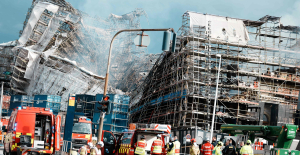 The main facade of the old Copenhagen Stock Exchange collapsed, two days after the fire started
The main facade of the old Copenhagen Stock Exchange collapsed, two days after the fire started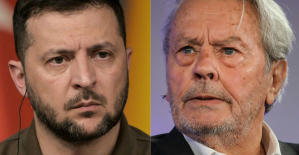 Alain Delon decorated by Ukraine for his support in the conflict against Russia
Alain Delon decorated by Ukraine for his support in the conflict against Russia Who’s Who launches the first edition of its literary prize
Who’s Who launches the first edition of its literary prize Sylvain Amic appointed to the Musée d’Orsay to replace Christophe Leribault
Sylvain Amic appointed to the Musée d’Orsay to replace Christophe Leribault Skoda Kodiaq 2024: a 'beast' plug-in hybrid SUV
Skoda Kodiaq 2024: a 'beast' plug-in hybrid SUV Tesla launches a new Model Y with 600 km of autonomy at a "more accessible price"
Tesla launches a new Model Y with 600 km of autonomy at a "more accessible price" The 10 best-selling cars in March 2024 in Spain: sales fall due to Easter
The 10 best-selling cars in March 2024 in Spain: sales fall due to Easter A private jet company buys more than 100 flying cars
A private jet company buys more than 100 flying cars This is how housing prices have changed in Spain in the last decade
This is how housing prices have changed in Spain in the last decade The home mortgage firm drops 10% in January and interest soars to 3.46%
The home mortgage firm drops 10% in January and interest soars to 3.46% The jewel of the Rocío de Nagüeles urbanization: a dream villa in Marbella
The jewel of the Rocío de Nagüeles urbanization: a dream villa in Marbella Rental prices grow by 7.3% in February: where does it go up and where does it go down?
Rental prices grow by 7.3% in February: where does it go up and where does it go down? With the promise of a “real burst of authority”, Gabriel Attal provokes the ire of the opposition
With the promise of a “real burst of authority”, Gabriel Attal provokes the ire of the opposition Europeans: the schedule of debates to follow between now and June 9
Europeans: the schedule of debates to follow between now and June 9 Europeans: “In France, there is a left and there is a right,” assures Bellamy
Europeans: “In France, there is a left and there is a right,” assures Bellamy During the night of the economy, the right points out the budgetary flaws of the macronie
During the night of the economy, the right points out the budgetary flaws of the macronie These French cities that will boycott the World Cup in Qatar
These French cities that will boycott the World Cup in Qatar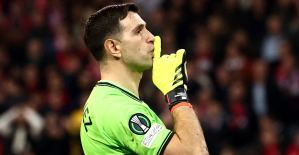 Europa Conference League: the semi-final flies to Lille, which loses to the wire against Aston Villa
Europa Conference League: the semi-final flies to Lille, which loses to the wire against Aston Villa Lille-Aston Villa: Cash disgusts Lille, the arbitration too... The tops and the flops
Lille-Aston Villa: Cash disgusts Lille, the arbitration too... The tops and the flops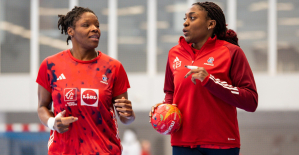 Handball: Les Bleues in the same group as Spain at Euro 2024
Handball: Les Bleues in the same group as Spain at Euro 2024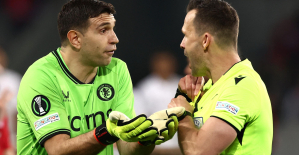 Europa Conference League: for Létang, Martinez “does not have the attitude of a high-level athlete”
Europa Conference League: for Létang, Martinez “does not have the attitude of a high-level athlete”


















